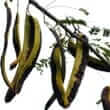Background
- Carob (Ceratonia siliqua) is a leguminous evergreen tree of the family Leguminosae (pulse family). Although it was originally native to Mediterranean regions, it is now cultivated in many warm climates, including Florida and California. The pods may be ground into a flour, which is often used as a cocoa substitute because it has a somewhat similar taste to chocolate and one-third the calories.
- Carob has been used to treat infantile diarrhea and carob bean gum has been used to control hyperlipidemia (high cholesterol) and as a dietary adjunct to elevated plasma cholesterol management.
- There is conflicting data on the effect of carob bean gum as a formula thickener and its effect on regurgitation frequency. The use of soluble dietary fibers, such as carob bean gum, has been shown to alter food structure, texture and viscosity, the rate of starch degradation during digestion, and the regulation of postprandial blood sugar and insulin levels.
- As a food, the U.S. Food and Drug Administration (FDA) has given carob generally recognized as safe (GRAS) status.
References
Natural Standard developed the above evidence-based information based on a thorough systematic review of the available scientific articles. For comprehensive information about alternative and complementary therapies on the professional level, go to . Selected references are listed below.
- Aggett PJ, Agostoni C, Goulet O, et al. Antireflux or antiregurgitation milk products for infants and young children: a commentary by the ESPGHAN Committee on Nutrition. J Pediatr Gastroenterol. Nutr 2002;34(5):496-498.
View Abstract - Borrelli O, Salvia G, Campanozzi A, et al. Use of a new thickened formula for treatment of symptomatic gastrooesophageal reflux in infants. Ital J Gastroenterol.Hepatol. 1997;29(3):237-242.
View Abstract - Carroll AE, Garrison MM, Christakis DA. A systematic review of nonpharmacological and nonsurgical therapies for gastroesophageal reflux in infants. Arch Pediatr Adolesc.Med 2002;156(2):109-113.
View Abstract - Gruendel S, Garcia AL, Otto B, et al. Carob pulp preparation rich in insoluble dietary fiber and polyphenols enhances lipid oxidation and lowers postprandial acylated ghrelin in humans. J Nutr 2006;136(6):1533-1538.
View Abstract - Guggenbichler JP. Adherence of enterobacteria in infantile diarrhea and its prevention. Infection 1983;11(4):239-242.
View Abstract - Kwiterovich PO Jr. The role of fiber in the treatment of hypercholesterolemia in children and adolescents. Pediatrics 1995;96(5 Pt 2):1005-1009.
View Abstract - Loeb H, Vandenplas Y, Wursch P, et al. Tannin-rich carob pod for the treatment of acute-onset diarrhea. J.Pediatr.Gastroenterol.Nutr. 1989;8(4):480-485.
View Abstract - McPherson V, Wright ST, Bell AD. Clinical inquiries. What is the best treatment for gastroesophageal reflux and vomiting in infants? J Fam.Pract. 2005;54(4):372-375.
View Abstract - Miyazawa R, Tomomasa T, Kaneko H, et al. Effect of locust bean gum in anti-regurgitant milk on the regurgitation in uncomplicated gastroesophageal reflux. J.Pediatr.Gastroenterol.Nutr. 2004;38(5):479-483.
View Abstract - Puntis JW. Re: Effect of locust bean gum in anti-regurgitant milk on the regurgitation in uncomplicated gastroesophageal reflux. J Pediatr Gastroenterol.Nutr 2005;40(1):101-102.
View Abstract - Savino F, Muratore MC, Silvestro L, et al. Allergy to carob gum in an infant. J.Pediatr.Gastroenterol.Nutr. 1999;29(4):475-476.
View Abstract - Trommer H, Neubert RH. The examination of polysaccharides as potential antioxidative compounds for topical administration using a lipid model system. Int J Pharm 7-14-2005;298(1):153-163.
View Abstract - Turnbull LA, Santamaria S, Martorell T, et al. Seed size variability: from carob to carats. Biology Letters 2006;2:397-400.
- Wenzl TG, Schneider S, Scheele F, et al. Effects of thickened feeding on gastroesophageal reflux in infants: a placebo-controlled crossover study using intraluminal impedance. Pediatrics 2003;111(4 Pt 1):e355-e359.
View Abstract - Zunft HJ, Luder W, Harde A, et al. Carob pulp preparation for treatment of hypercholesterolemia. Adv.Ther. 2001;18(5):230-236.
View Abstract







